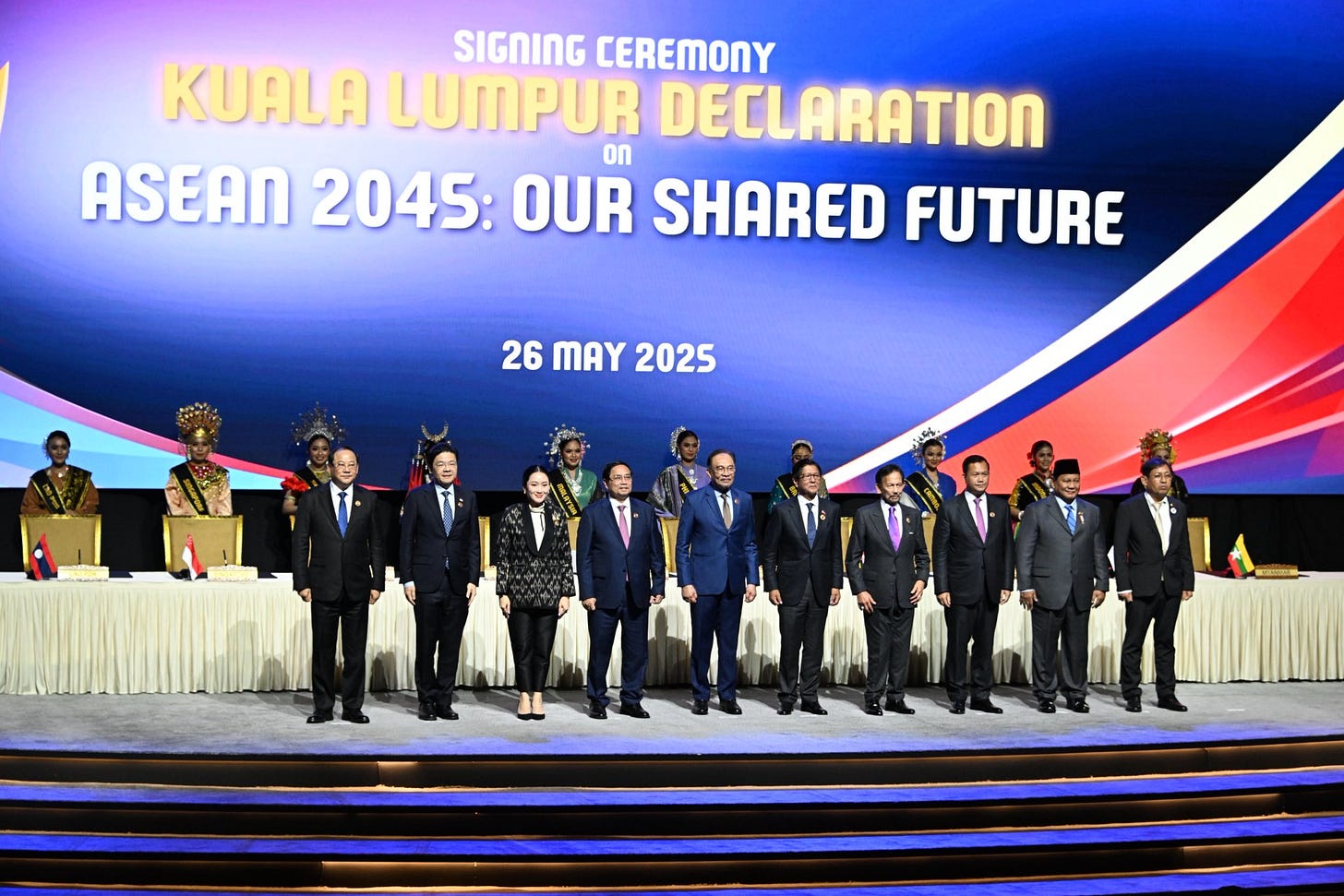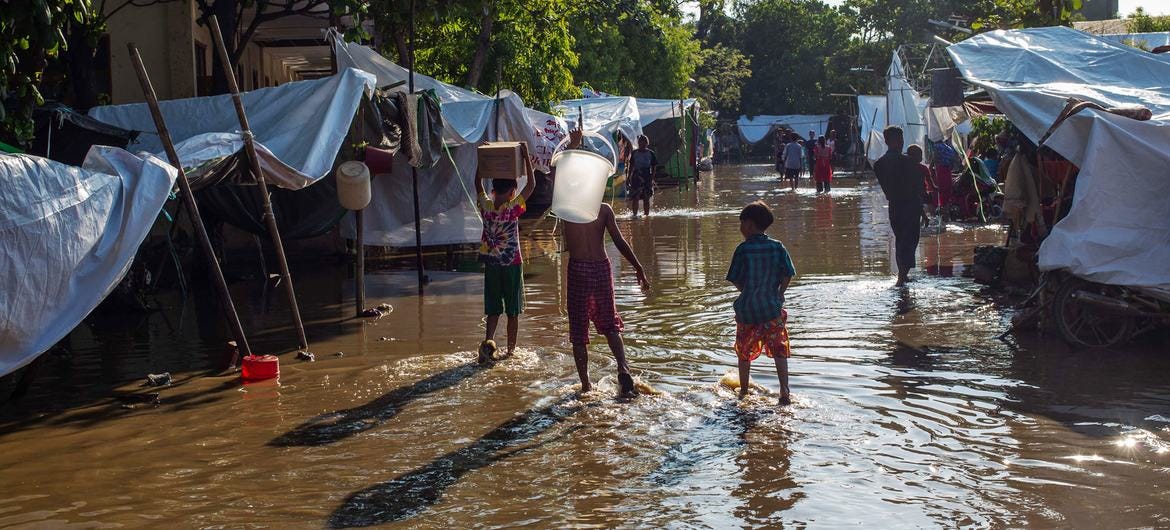At Shangri-La Dialogue 2025, US Unveils New Defense Vision
Plus border clash fallout; new artificial intelligence body; quiet digital sanctions; big tech plan approval; mining project spotlight and much, much more.
Greetings to new readers and welcome all to the latest edition of the weekly ASEAN Wonk BulletBrief! If you haven’t already, you can upgrade to a paid subscription for $5 a month/$50 a year below to receive full posts by inserting your email address and then selecting an annual or monthly option. You can visit this page for more on pricing for institutions, groups as well as discounts. For current paid subscribers, please make sure you’re hitting the “view entire message” prompt if it comes up at the end of a post to see the full version.
For this iteration of ASEAN Wonk BulletBrief, we are looking at:
Assessing the geopolitical and geoeconomic significance of the dynamics at the 2025 Shangri-La Dialogue in Singapore, including datapoints from official interventions and policy implications;
Mapping of regional developments, including a new ASEAN strategy rollout and a subregional border clash fallout;
Charting evolving geopolitical, geoeconomic and security trends such as big defense deal; new artificial intelligence body; and quiet digital sanctions;
Tracking and analysis of industry developments and quantitative indicators including future high-tech plan approval; shadowy regional transfer and mining deal momentum;
And much more! ICYMI, check out our ASEAN Wonk review of a new book on Putin’s Russia and the Kremlin’s future Southeast Asia strategy.
This Week’s WonkCount: 2,256 words (~10 minutes)
New ASEAN Strategy Rollout; Border Clash Fallout & More
Defense Partnership Drilldown; Regional Outlook & Conflict Futures
“New defense-industrial actors from the Gulf Arab states…have recently grown their partnerships with major Asia-Pacific countries," argues a new chapter from the International Institute for Strategic Studies’s Asia-Pacific Regional Security Assessment 2025 published alongside the convening of the Shangri-La Dialogue. The chapter examines how Asian states are engaging in a wide range of defense-industrial partnerships with regional and extraregional counterparts, including examples such as the Indian-Russian BrahMos supersonic missile program and the Global Combat Aircraft Program anchored by Italy, Japan and the United Kingdom (link).
Graphic With Tiered Arms Producer Model Ideal Types
“There would be a mid-term review of the 20-year vision…this was meant to ensure that the vision and its strategic plans remain adaptive and relevant to the changing needs and responsive to the environment,” notes the ASEAN Secretary-General Kao Kim Hourn in a special edition of commentaries published by CSIS Jakarta on ASEAN’s newly-released community-building vision out to 2045. The compilation of commentaries includes other perspectives including from Malaysia’s permanent representative to ASEAN on the chairmanship agenda and East Timor’s ambassador to ASEAN on the country’s pursuit of full membership within the regional grouping (link).
“Comparative performance analysis showcased massive economic losses and the diversion of resources away from development," observes a preview copy of a forthcoming United Nations report to be released at a July 1 session on the ongoing geopolitical and geoeconomic situation in Myanmar. The report notes that military operations killed more civilians in the past year than in any previous year since the 2021 military coup, and that the country’s gross domestic product at best is not expected to recover to pre-pandemic levels before 2028. It also identifies key “constituents for change” in the country’s future, including women, youth, ethnic minorities, civil society and pro-democracy actors (link).
At Shangri-La Dialogue 2025, US Unveils New Defense Vision
What’s Behind It
Defense Secretary Pete Hegseth unveiled the outlines of the U.S. administration’s forthcoming defense approach at the Shangri-La Dialogue (SLD) in Singapore grounded in “re-establishing deterrence,” even as several official interventions reflected lingering uncertainties on U.S. policy1. The general reception to Hegseth’s SLD appearance among officials that ASEAN Wonk engaged with echoed what was heard when he made his first Indo-Pacific trip back in March amid speculation over the timeline of the administration’s national defense strategy release — that while some of his words could have been uttered by a defense official from any previous U.S. administration, he was offering reassurance on U.S. commitment in the area where it is arguably least needed given disruptions in non-defense aspects of U.S. policy. As one official present at the SLD put it to ASEAN Wonk, if some in the region spent the initial part of the Biden administration wondering what the term “integrated deterrence” concretely meant, that sense of integration may now in fact be welcomed given what seems like a U.S. defense approach disintegrated from other aspects of U.S. policy including tariffs in the economic domain2.
Select Key Headline Developments in Southeast Asia Amid 2025 Shangri-La Dialogue
The focus on U.S. policy also belied other important Indo-Pacific policy datapoints that were witnessed across multiple dialogue sessions. Despite the absence of China’s defense minister this year, it did not go unnoticed by regional officials carefully watching the deliberations that prepared remarks by the Chinese representative — as suspected — folded in recent bilateral maritime ‘understandings’ reached with both Indonesia and Malaysia as evidence of Beijing’s good conduct at sea, even as its South China Sea provocations have continued3. Meanwhile, Japan played up the addition of “OCEAN” to its list of Indo-Pacific acronyms which includes “JASMINE” with ASEAN, reinforcing Tokyo’s important regional role which was on display with various engagements during the week such as summit engagements with Cambodia and Laos4.
Why It Matters
Key interventions by Indo-Pacific states provided a window into significant datapoints to watch in Asia’s evolving security landscape (see two tables below summarizing major datapoints, along with more on the future prospects in the “Where It’s Headed” section. Paid subscribers can read on thereafter to remaining sections of our weekly ASEAN Wonk BulletBrief).












